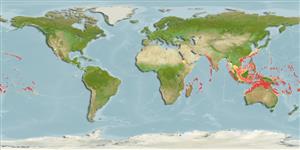>
Holocentriformes (Squirrelfishes, soldierfishes) >
Holocentridae (Squirrelfishes, soldierfishes) > Holocentrinae
Etymology: Sargocentron: Greek, sargos = sargus + Greek, kentron = sting (Ref. 45335).
More on author: Günther.
Environment: milieu / climate zone / depth range / distribution range
Écologie
marin récifal; profondeur 0 - 183 m (Ref. 1602), usually 1 - 35 m (Ref. 58302). Tropical; 35°N - 25°S
Indo-Pacific: Chagos Archipelago, Astove in Seychelles, and Maldives to the Hawaiian, Line, and Tuamoto Islands, north to the Ryukyu and Bonin Islands, south to Austral Islands; throughout Micronesia.
Taille / Poids / Âge
Maturity: Lm ? range ? - ? cm
Max length : 20.0 cm TL mâle / non sexé; (Ref. 4201)
Épines dorsales (Total): 11; Rayons mous dorsaux (Total): 12-14; Épines anales 4; Rayons mous anaux: 9 - 10. Body with red and white stripes of different widths; head reddish above, silvery below; faint red band from eye to angle of preopercle; spinous dorsal white, with a submarginal zone of red (Ref. 4201). Five oblique scale rows on cheek; body moderately elongated, depth 2.9-3.5 in SL; head length (HL) 2.8-3.4 in SL; snout length 3.9-4.35 in HL; interorbital width 4.15-4.5 in HL; maxillary reaching to about below front of iris, upper jaw length 2.85-3.15 in HL; premaxillary groove reaching to about a vertical at the front edge of orbit; anterior end of nasal bone rounded; 1-2 spinules at medial margin of nasal bone; small nasal fossa without spinules on its edge (except a 16.3 cm specimen from the Society Islands with 1 spinule); upper edge of suborbital bone weakly serrated, spineless laterally; short preopercular spine 1/4-1/3 orbit diameter, 6.15-7.95 in HL; 3rd-5th dorsal spine longest 1.5-1.95 in HL; extremely long 3rd anal spine 1.0-1.2 in HL (Ref. 27370).
Inhabits virtually all coral reef zones (Ref. 1602). Benthopelagic in or near crevices and holes (Ref. 58302). Common in thickets of staghorn Acropora or in large Pocillopora heads (Ref. 1602). Feeds on small crustaceans, worms, and fishes during the night (Ref. 30874). Spine of preopercle venomous. Minimum depth reported taken from Ref. 128797.
Life cycle and mating behavior
Maturité | Reproduction | Frai | Œufs | Fécondité | Larves
Randall, J.E., 1998. Revision of the Indo-Pacific squirrelfishes (Beryciformes: Holocentridae: Holocentrinae) of the genus Sargocentron, with descriptions of four new species. Indo-Pac. Fish. (27):105 p. (Ref. 27370)
Statut dans la liste rouge de l'IUCN (Ref. 130435)
Utilisations par l'homme
Aquarium: Aquariums publics
Plus d'informations
RéférencesAquacultureProfil d'aquacultureSouchesGénétiqueElectrophoresesHéritabilitéPathologiesTraitementNutrientsMass conversion
Outils
Articles particuliers
Télécharger en XML
Sources Internet
Estimates based on models
Preferred temperature (Ref.
123201): 24.9 - 29, mean 27.8 °C (based on 1198 cells).
Phylogenetic diversity index (Ref.
82804): PD
50 = 0.5000 [Uniqueness, from 0.5 = low to 2.0 = high].
Bayesian length-weight: a=0.01585 (0.00935 - 0.02687), b=3.13 (2.99 - 3.27), in cm total length, based on LWR estimates for this species & Genus-body shape (Ref.
93245).
Niveau trophique (Ref.
69278): 3.6 ±0.58 se; based on food items.
Generation time: 1.1 ( na - na) years. Estimated as median ln(3)/K based on 1
growth studies.
Résilience (Ref.
120179): Haut, temps minimum de doublement de population inférieur à 15 mois (K=1.00).
Fishing Vulnerability (Ref.
59153): Low vulnerability (14 of 100).
Nutrients (Ref.
124155): Calcium = 61.9 [24.5, 260.2] mg/100g; Iron = 0.561 [0.226, 1.701] mg/100g; Protein = 18.5 [17.3, 19.7] %; Omega3 = 0.176 [0.075, 0.404] g/100g; Selenium = 44.8 [25.8, 85.6] μg/100g; VitaminA = 69.7 [27.0, 189.4] μg/100g; Zinc = 1.91 [0.79, 3.57] mg/100g (wet weight);
